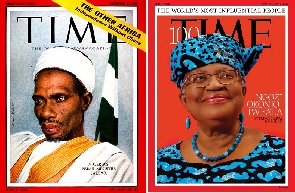Immediately after Nigeria's February 25 election, a viral photo popped up of opposition Labour Party (LP) candidate Peter Obi on the front page of the American news publication, Time Magazine.
A fact check by FactSpace revealed that the said photo was doctored and that Obi had at no point before or during his run for president been featured on the front page of the Time Magazine.
That, however, does not take away the fact that other Nigerians in the past and more recently have made it to the front of the paper.
MyNigeria’s checks brought up two names prominently, both politicians in the own right.
Who are these two?
Abubakar Tafawa-Balewa
Our checks with the Time website shows that the former Prime Minister was featured on December 5, 1960; the year of Nigeria’s independence. The page had Tafawa Balewa’s portrait with a Nigerian flag behind him.
Some inscriptions included: The Other Africa: Independence Without Chaos. Nigeria’s Prime Minister Balewa.
Ngozi Okonjo-Iweala, September 2021
In September 2021, over six decades after Tafawa Balewa, Ngozi Okonjo-Iweala, made it to the cover of the Time Magazine as part of the Time 100 personalities for the year.
The former Finance Minister had at the time become the first woman to lead the World Trade Organization, a 164-member group of nations that oversees trade across the world in March that year.
The writeup celebrating her feat was titled: "What will it take to vaccinate the world? Unity, cooperation—and leaders like Ngozi Okonjo-Iweala."
It was written by Prince Harry and Meghan, The Duke and Duchess of Sussex.
FACT-CHECK: Claim: Peter Obi featured on the front page of Time Magazine
Source: Twitter
Verdict: FALSE
Researched by Gifty Tracy Aminu
Has Nigeria’s Presidential aspirant Peter Obi been featured on the front page of Time Magazine?
A viral tweet that is also being shared on WhatsApp comes with the supposed Time Magazine front cover showing Peter Obi, with the caption: “His Labour Party is favoured to win the Nigerian Presidency.”
The tweet has been viewed more than 600,000 times and generated close to 30,000 engagements in the form of retweets and likes.
What is Time Magazine?
Time is an American news magazine based in New York City.
First published in 1923, Time has become a leading news magazine and an appearance on the cover of Time has become an indicator of notability, fame or notoriety.
Fact-check
Checks by FactSpace from Time Magazine’s archive of front covers for 2023 showed there have been four published covers this year and none featured the picture of Peter Obi.
A forensics analysis of the viral front cover using the InVID verification tool has subsequently shown that the image is likely to have been manipulated.
The toolkit detected image forgery, showing some inconsistencies in the image pattern and the introduction of foreign images likely inserted into an existing image.
FactSpace analysis would focus on the following areas: Double Quantization, BLOCK algorithm and Discrete Cosinus Transform (DCT) to verify the image.
Double Quantization: Double Quantization inconsistencies occur when a foreign object is inserted in a JPEG image.
When the new image is saved, the untampered part of the image will have been compressed twice, while the inserted region only once. In this case, the tampered area should appear light-coloured (see the scale) while the rest of the image remains dark. If other colours are present (green, blue) then no conclusion can be made.
Also, the light-coloured region must be object-like: spurious light dots scattered across the image should be ignored.
Evaluation: The tampered area appeared light-coloured which showed inconsistencies when the new image was inserted.
BLOCK: JPEG compression operates in an 8-by-8 grid, which is near-invisible but detectable. Adding or moving an object on an image may locally disrupt this grid. The BLOCK algorithm detects the image grid and looks for local discrepancies.
Any coherent region with a different colour to its surroundings may correspond to tampering, although white and light green against a dark background are the most typical indication of tampering.
As this algorithm is often misguided by differences in texture and focus, it is best interpreted in combination with other algorithms.
Evaluation: There were white and light-green colours against a dark background which typically indicates tampering.
DCT: When tampering takes place in a JPEG image, the Discrete Cosinus Transform (DCT) coefficients (a mathematical operation) may be locally disturbed. Regions that stand out (white or light green) against a black background may correspond to tampering. The reverse may also hint towards tampering, i.e. certain regions appearing bluer against a black background.
Evaluation: There were regions that stood out as white or light green against a black background and that shows the image was likely manipulated.
Verdict
The claim is FALSE and the picture has been manipulated.
Africa News of Monday, 27 February 2023
Source: mynigeria.com

















